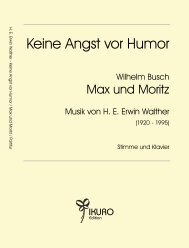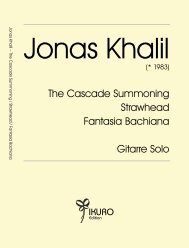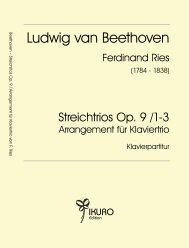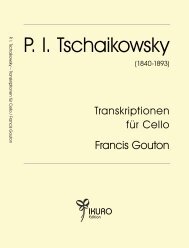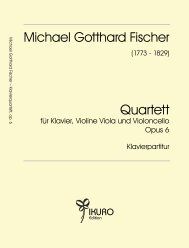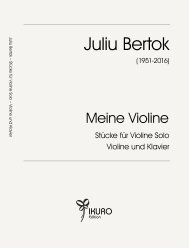IKURO 210303-10
Johann Matthias Sperger – Konzert Nr. 8 in D für Kontrabass und Orchester / Partitur
Johann Matthias Sperger – Konzert Nr. 8 in D für Kontrabass und Orchester / Partitur
Erfolgreiche ePaper selbst erstellen
Machen Sie aus Ihren PDF Publikationen ein blätterbares Flipbook mit unserer einzigartigen Google optimierten e-Paper Software.
Johann Matthias Sperger<br />
Concerto for double bass and orchestra<br />
D major No. 8 (T8)*<br />
After completing his eighteen double bass concertos,<br />
Johann Matthias Sperger arranged the autograph scores and<br />
orchestral parts in folders and assigned the number 8 to this<br />
concerto. *see footnote 2.<br />
Written by his hand, the envelope reads:<br />
Nr.8 Concerto in Es per il Contrabasso, Due Violini, Due<br />
Oboi, Due Corni, Viola et Basso di Giov. Sperger<br />
Notes on editing the solo part:<br />
? ∑ ∑ ∑ ∑<br />
# œ œ œ œ<br />
since the original was composed for the so-called „Viennese<br />
double bass“ with the A-d-f sharp-a tuning<br />
?<br />
œ œ # œ œ<br />
∑ ∑ ∑<br />
at that time, the slightest interventions for today’s solo tuning<br />
18<br />
were inevitable.<br />
? ∑<br />
While maintaining the melodic lines, the editors recommend<br />
leaving out the double stops. At that time, due to the „tuning<br />
in thirds-and-fourths“, these 19 were relatively easy to grasp,<br />
but on the fourth-tuned solo double bass used today they take<br />
away the clarity of the melody in the lower registers.<br />
? ∑ ∑ ∑ ∑ ∑ ∑<br />
In the edition, however, all the original second parts are<br />
preserved (in small print) 29- for those soloists who might want<br />
to play a double stop here and there.<br />
? ∑ ∑ ∑ ∑ ∑ ∑<br />
In the second movement, the editors suggested lower octaves<br />
in some places, which should be performed ad libitum.<br />
39<br />
? ∑ ∑ ∑ ∑ ∑ ∑<br />
For the players in the original „Viennese tuning“, Sperger’s<br />
original notation is available in an enclosed solo part. The<br />
original notation can also be found in the score and piano<br />
reduction.<br />
49<br />
? ∑ ∑ ∑ ∑ ∑ ∑<br />
The first two movements in the edition follow exactly the<br />
preserved autographs of the score and the solo part. The third<br />
movement differs slightly in score and solo part – the editors<br />
59<br />
decided to use the autograph score.<br />
? ∑ ∑ ∑ ∑ ∑ ∑<br />
It is completely preserved in Sperger’s handwriting as a score<br />
and double bass solo part in the original – as is a set of parts.<br />
The score is in the key of E flat major - the solo double bass is<br />
notated in D major, with the soloist using the scordatura that<br />
was customary at that time and tuning his instrument one<br />
semitone higher.<br />
This first edition appears in D major; the double bass solo<br />
part in edited form for the solo tuning common today:<br />
F sharp-B-e-a<br />
and in the original Sperger notation for the „Viennese tuning“.<br />
Sperger is noticeably reluctant to use the dynamic designation<br />
in the solo part. He leaves the soloist complete freedom.<br />
Only after a designated dolce passage, that was designated<br />
by Sperger, what is to be equated with a piano, he then<br />
prescribes a forte at the appropriate point. In the score, on the<br />
other hand, he specifies his dynamic ideas for the orchestra’s<br />
preludes and interludes - alternating between forte and piano.<br />
Sperger’s complete handling of the orchestral accompaniment<br />
is masterly. Reduced string line-ups and pausing winds when<br />
the solo instrument is used, allow the solo double bass to<br />
always take precedence. Sperger only uses the full orchestra<br />
for all preludes and interludes. Sperger’s handling of the<br />
orchestra shows an extremely intelligent approach.<br />
? ∑ ∑ ∑ ∑ ∑ ∑ ∑ ∑<br />
# œ œ œ œ<br />
Sperger’s severity in classical musical form, which can be<br />
observed again and again, is also to be found in this Concerto<br />
No. 8.<br />
?<br />
œ œ # œ œ<br />
∑ ∑ ∑ ∑ ∑ ∑ ∑



